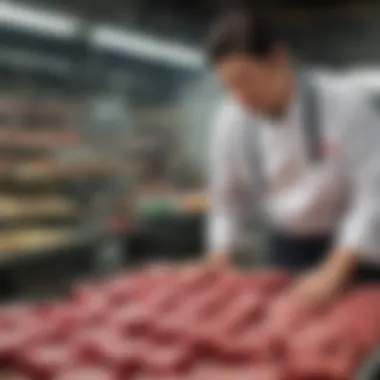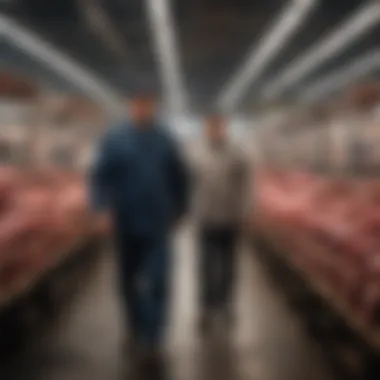A5 Wagyu Beef Market Insights and Price Dynamics


Intro
The A5 Wagyu beef market stands as an esteemed segment within the culinary world, recognized for its exceptional quality and flavor. Understanding this market involves analyzing various dynamics that influence its pricing and availability. Factors such as global demand, supply chain challenges, and consumer preferences play critical roles in shaping the landscape of A5 Wagyu beef.
A5 grade indicates the highest quality within the Wagyu classification, based not only on marbling but also on color, texture, and fat quality. As culinary enthusiasts and professionals venture into this market, grasping these price dynamics becomes essential, ensuring that they can make informed decisions. This article explores the intricacies of the A5 Wagyu beef market to provide valuable insights for its stakeholders.
Market Dynamics
Price fluctuations in the A5 Wagyu beef market stem from several interconnected factors. The scarcity of true A5 Wagyu beef due to its unique breeding and rearing processes contributes significantly to its high prices.
- Global Demand: Increased interest in high-quality beef has driven up demand not only in Japan but also internationally. Developing markets and rising consumer affluence in countries like the United States and Australia fuel this growing appetite.
- Supply Chain Challenges: The journey of A5 Wagyu from farm to table involves numerous logistical hurdles. Restrictions on importation, quality control standards, and consumer education contribute to the complexities in sourcing and distribution.
- Consumer Preferences: As people become more discerning about their food choices, the demand for premium quality ingredients has escalated. Culinary professionals strive to use the best products, while home cooks search for ways to elevate their dishes, pushing A5 Wagyu into the spotlight.
Sourcing A5 Wagyu
Finding authentic A5 Wagyu is not a simple task. It requires knowledge of reputable suppliers and an understanding of authenticity indicators. When searching for A5 Wagyu, consider the following:
- Certification: Look for cuts that come with certification from the Japanese Meat Grading Association.
- Reputable Vendors: Engage with well-known suppliers like Snake River Farms and Crowdcow to ensure quality.
- Regional Variants: Be aware that there are regional variations of Wagyu, including Kobe beef, which may offer differing characteristics and price points.
"True A5 Wagyu is rare and comes from specific bloodlines and regions in Japan, making its sourcing a complex process."
Consumer Implication
The implications of A5 Wagyu sourcing extend beyond just purchasing decisions. Culinary practices evolve as chefs experiment with this luxurious ingredient. As a part of fine dining experiences, A5 Wagyu is often the centerpiece of gourmet dishes, showcasing innovative techniques that honor its rich flavor.
Additionally, as more chefs integrate A5 Wagyu into their menus, it influences pricing and availability in local markets. Consumers increasingly become educated about the origins and value of A5 Wagyu, which can shift purchasing behavior toward premium options.
This awareness benefits the market as it evolves, paving the way for more sustainable practices and broader access to high-quality ingredients in culinary experiences. By understanding these nuances, both culinary enthusiasts and industry stakeholders can navigate the intricate landscape of the A5 Wagyu beef market successfully.
Understanding A5 Wagyu Beef
The A5 Wagyu beef market is a fascinating subject. It bridges the gap between high-end culinary art and agricultural precision. Understanding this segment dives into several aspects. First, the classification itself is critical. Knowing how A5 is defined helps in comprehending its value. Second, the qualities that differentiate A5 Wagyu from other beef types must not be overlooked. Last but not least, the origins and the breeding process of A5 Wagyu enrich the narrative. Together, these elements provide a well-rounded view of this gourmet product.
Definition and Classification
A5 Wagyu refers to beef from Japanese cattle, specifically with a grade of A5. The grading system encompasses factors like yield and quality. A5 denotes the highest quality available. Within Wagyu, there are various types, including Kobe and Matsusaka. Each has its unique characteristics, but all share the common marker of exceptional marbling. Understanding these classifications aids consumers in making informed choices in restaurants and markets.
Distinctive Qualities of A5 Wagyu
A5 Wagyu is recognized for its rich flavor and tender texture. The high level of intramuscular fat creates a buttery mouthfeel. Another distinctive quality is the unique marbling, often compared to artistic patterns. This marbling enhances not only taste but also the experience of consuming the beef. The fatty acids present in A5 Wagyu can also have health benefits, making it a choice that balances indulgence with nutrition. Consumers can savor not just the taste but also the richness that comes from high-quality Wagyu.
Origin and Breeding Process
The origin of A5 Wagyu is deeply rooted in Japan. It starts with specific breeds such as the Japanese Black. These cattle are raised under strict conditions, including specialized feeding and attention to their environment. The breeding process can take several years. Farmers often employ traditional methods, ensuring that each cow receives personalized care. Such practices contribute significantly to the quality and classification, ultimately impacting the price. In simple terms, a well-cared-for cow results in superior beef that commands premium prices.
"A5 Wagyu is not just a product; it is an experience that speaks to the artistry of both farming and culinary expertise."
By exploring these facets, one begins to appreciate not just the complexity but also the artistry behind A5 Wagyu beef. This understanding is pivotal for anyone involved in the culinary field.
Market Overview of A5 Wagyu Beef
The A5 Wagyu beef market represents a unique sector of the culinary world. Understanding its market dynamics offers essential insights for both industry professionals and culinary enthusiasts. The factors influencing A5 Wagyu's market are critical for those wanting to comprehend its pricing and sourcing intricacies.
Global A5 Wagyu Demand Trends
The demand for A5 Wagyu beef has grown significantly in various global regions. This beef stands out due to its exceptional quality, characterized by its intense marbling and tenderness. The unique flavor profile has led to an increasing number of high-end restaurants and culinary events featuring this delicacy. Consumers are more knowledgeable about quality distinctions, driving demand higher.
Several factors contribute to these trends:


- Culinary Innovation: Chefs are experimenting with A5 Wagyu in diverse recipes, enhancing its visibility.
- Social Media Influence: Photogenic presentations lead to increased interest and demand online.
- Globalization of Cuisine: As culinary traditions blend, A5 Wagyu becomes more appealing to a broader audience.
Overall, demand continues to rise as consumers seek premium products that offer both taste and a unique dining experience.
Key Players in the Market
Identifying the key players in the A5 Wagyu beef market is crucial. Different companies supply this prized beef, sourcing it from various regions, primarily Japan. Notable players include:
- Miyazaki Beef Association: Known for promoting high-quality Wagyu beef from Miyazaki Prefecture.
- Kobe Beef Marketing and Distribution Promotion Association: This organization maintains standards for authentic Kobe Beef, an important segment of the overall Wagyu market.
- Online Retailers: Companies such as Crowd Cow and Snake River Farms have made A5 Wagyu accessible to consumers beyond traditional markets.
Each player brings unique strengths, whether in breeding practices, distribution, or innovations in culinary applications. Their contributions collectively shape the landscape of A5 Wagyu beef, ensuring businesses can meet market demands.
Regions Dominating A5 Wagyu Production
Wagyu beef production is not uniform across the globe. Japan is the original producer, especially known for regions such as:
- Kobe: Famous worldwide for its exceptional marbled beef.
- Miyazaki: Recognized for both quality and strict production regulations.
- Okayama: This region is also gaining traction for its premium Wagyu offerings.
Other countries, like the United States and Australia, have emerged as noteworthy producers. They follow Japanese breeding practices and have been able to market their Wagyu successfully. However, the traditional Japanese Wagyu still holds the highest prestige and reputation among consumers.
To summarize, a comprehensive understanding of these sectors provides valuable insights into the wider A5 Wagyu market, making this information essential for culinary professionals and enthusiasts.
Factors Affecting A5 Wagyu Beef Prices
Understanding the dynamics of A5 Wagyu beef prices is crucial for both consumers and industry stakeholders. Pricing reflects not only the quality of the product but also the complex web of supply chains, consumer behavior, and economic indicators. Recognizing these factors can provide insights into how to make informed purchasing decisions, whether for personal enjoyment or for a culinary business.
Supply Chain Variables
The supply chain for A5 Wagyu beef is multi-faceted and greatly influences its pricing. From farm to table, each step adds costs.
- Breeding and Raising: A5 Wagyu beef originates from specific breeds, such as the Japanese Black cattle. Raising these animals involves meticulous care, specific diets, and optimal living conditions, all of which contribute to the final price.
- Transportation: This type of beef often travels long distances. Logistics and transportation costs inevitably raise prices. Delays or disruptions in transport can also lead to increased prices due to scarcity.
- Processing and Distribution: Processing involves various stages, including butchering and packaging. Each of these steps has associated costs. Distributors who specialize in premium products often charge more, impacting retail prices.
Consumer Preferences and Trends
Consumer habits greatly shape A5 Wagyu beef prices. As interest in gourmet dining rises, so too does demand for specialty foods like A5 Wagyu. Some influential aspects include:
- Quality Awareness: Consumers are becoming more educated about meat quality, leading to increased demand for authentic A5 Wagyu. This knowledge drives prices higher.
- Dining Experiences: High-end restaurants and culinary events spotlight A5 Wagyu, affecting market perceptions and pricing strategies. Diners willing to pay a premium for unique experiences often push prices upward.
- Culinary Trends: The rise in social media influence has glamorized premium foods, including A5 Wagyu. As more people share their experiences online, this drives further interest and demand.
Understanding these consumer trends helps explain why A5 Wagyu beef prices can vary significantly from one region to another.
Economic Influences and Price Fluctuations
The economy plays an essential role in the pricing landscape of A5 Wagyu beef. Several economic factors influence prices, and their interrelation can create volatility.
- Market Demand and Supply: A basic principle of economics applies—when demand exceeds supply, prices rise. Conversely, when production exceeds demand, prices may drop. Fluctuations in wagyu supply due to external factors, such as natural disasters or disease, can impact availability and thus prices.
- Global Economic Conditions: Currency fluctuations and global trade policies can affect import prices. Rising tariffs or trade disputes can lead to higher prices for imported A5 Wagyu.
- Inflation and Cost of Goods: Rising costs in agriculture and transportation due to inflation can translate to higher prices for consumers. Monitoring these economic indicators can provide hints about future pricing trends.
Understanding these economic influences is essential for forecasting price movements in the A5 Wagyu beef market.
Current Market Pricing Analysis
The current landscape of A5 Wagyu beef pricing is crucial for understanding its market dynamics. By analyzing pricing, stakeholders can make informed decisions regarding sourcing and selling, thus ensuring both profitability and customer satisfaction. The pricing of A5 Wagyu is influenced by numerous factors, including supply capabilities, consumer demand, and quality assessments. These elements intertwine to create a pricing structure that is often elusive to comprehend.
Price Ranges and Variations
Price ranges for A5 Wagyu can be quite broad, reflecting variations in sourcing and quality grades. Typically, prices can range from $300 to $600 per kilogram, depending on the specific cut and the supplier’s reliability. Factors influencing these ranges include:
- Geographical differences: Regions known for high-quality production, like Kagoshima and Kobe in Japan, often command higher prices.
- Cut specifics: Premium cuts, such as tenderloin and ribeye, are priced higher than lesser-known cuts.
- Market fluctuation: Changes in supply and demand can lead to significant price variations, especially during peak buying seasons.
Monitoring these variables is essential for both buyers and sellers to navigate fluctuations in the market effectively.


Influence of Quality Grading on Pricing
Quality grading significantly impacts the price of A5 Wagyu. The grading system takes into consideration the marbling, meat color, fat color, brightness, texture, and firmness. The highest quality, A5, signifies exceptional marbling, making it more desirable and, thus, more expensive. Buyers must understand how these grades affect the cost.
- Quality grades: A5 is the top tier, followed by A4 and A3, each descending grade reflecting lower marbling and quality.
- Consumer perception: Many buyers equate higher grades with better taste and cooking experiences.
- Sourcing implications: Suppliers may charge higher prices for A5 grades, reflecting their increased efforts to maintain standards during production and transportation.
Comparative Pricing with Other Beef Types
When comparing A5 Wagyu to other beef types, the pricing hierarchy becomes evident. A5 Wagyu can be drastically more expensive than standard beef cuts due to its unique qualities. For a comparative perspective:
- USDA Prime: Typically priced between $20 to $50 per kilogram, this quality is sought after in the American market but does not match the marbling of A5.
- Grass-fed beef: Prices are often lower, between $15 to $30 per kilogram, highlighting a significant difference in the market.
- Angus beef: Prices vary but usually range from $30 to $60 per kilogram, showcasing another tier in the beef landscape.
Understanding these price differences helps consumers and culinary professionals appreciate the unique value of A5 Wagyu in their culinary applications.
Sourcing A5 Wagyu Beef
Sourcing A5 Wagyu beef is crucial in understanding the entire A5 Wagyu beef market. It involves identifying reliable suppliers, assessing quality, and navigating the complexities of import logistics. For culinary enthusiasts and professionals, knowing how to source A5 Wagyu is essential in ensuring the quality of the dishes they create. A consistent supply of high-quality beef not only enhances culinary experiences but also contributes to the reputation of chefs and brands in a competitive market.
Reputable Suppliers and Distributors
When sourcing A5 Wagyu beef, partnering with reputable suppliers is vital. This can influence quality, availability, and pricing. Choosing suppliers with established histories often guarantees authenticity and compliance with strict grading standards inherent to A5 Wagyu. Some of the notable suppliers include Aubrac Farms and Snake River Farms. Reliable distributors often have direct communication with producers, enabling better control over the product supply and ensuring fresh deliveries.
- Key considerations in supplier selection:
- Verify certifications and pedigree
- Assess product traceability
- Evaluate supplier reviews
- Confirm distribution capabilities
Evaluating Authenticity and Quality
Determining the authenticity of A5 Wagyu beef requires careful evaluation. Many products in the market claim to be A5 but may not meet the stringent standards. Chefs and culinary professionals need to familiarize themselves with the Japanese Agricultural Standard (JAS) that governs the classification of Wagyu. This includes understanding marbling scores, color, and texture.
To ensure quality, consider these steps:
- Request Documentation: Always ask for traceability papers and quality certificates.
- Conduct Taste Tests: Sampling the product before purchasing can reveal texture and flavor differences.
- Inspect Packaging: Authentic A5 Wagyu should have clear labels with origin details.
"The assurance of authenticity not only elevates the dining experience but also builds trust with customers."
Logistical Considerations for Import
Importing A5 Wagyu beef involves logistical complexities. Regulations may vary between countries, and complying with local food safety laws is necessary. Understanding customs duties and import protocols is critical for ensuring timely deliveries. Furthermore, products should maintain cold chain logistics during transport to preserve quality and freshness.
Important logistical factors include:
- Shipping Methods: Evaluate the best shipping options based on cost and speed.
- Storage Facilities: Ensure proper storage conditions upon arrival to avoid spoilage.
- Regulatory Compliance: Always stay updated with changing import regulations to avoid legal issues.
In summary, effective sourcing of A5 Wagyu beef is a multifaceted process. By focusing on credible suppliers, authenticating product quality, and managing logistical challenges, culinary professionals can guarantee excellent beef that enhances their culinary offerings.
Culinary Applications of A5 Wagyu
The culinary applications of A5 Wagyu are crucial to understanding its value in both high-end restaurants and home kitchens. This beef offers a unique flavor profile and texture that elevate dishes, making it a sought-after ingredient for chefs and food enthusiasts. Knowing how to utilize A5 Wagyu properly ensures its qualities shine, providing both culinary delight and a worthwhile dining experience.
Cooking Techniques for Optimal Taste
Cooking A5 Wagyu requires careful attention to techniques that preserve its rich marbling and softness. The following methods are recommended:
- Searing: Cooking A5 Wagyu at a high temperature for a short time locks in juices and maintains the tenderness. A hot cast iron skillet or grill works well.
- Sous Vide: This method offers precision, allowing for perfect doneness. Cooking at lower temperatures for longer periods enhances the beef's flavor without compromising its texture.
- Tartare or Carpaccio: Serving A5 Wagyu raw in dishes like tartare or carpaccio highlights its exquisite flavor and buttery texture. Freshness is crucial, thus sourcing high-quality meat is essential.
Each technique enhances the inherent characteristics of A5 Wagyu, making it an exciting and rewarding ingredient to work with.
Pairing A5 Wagyu with Other Ingredients


Pairing A5 Wagyu should focus on complementing its rich taste without overpowering it. Here are some suggestions:
- Simple Flavors: Ingredients like sea salt and cracked black pepper accentuate the meat's natural umami without distracting from its essence.
- Acidic Elements: Incorporate acidic components such as citrus or vinegar-based sauces that cut through the richness, providing balance.
- Light Vegetables: Pairing with fresh greens like arugula or lightly cooked asparagus adds texture and freshness, making the dish more complex yet harmonious.
- Asian Flavors: Ingredients like soy sauce, miso, or sesame oil can enhance the beef’s profile, creating fusion dishes that respect its roots.
Understanding flavor dynamics helps create dishes where A5 Wagyu can be enjoyed fully.
Presentation and Serving Suggestions
Presentation of A5 Wagyu is vital to its appeal. Here are essential tips for serving this premium beef:
- Plating: Use minimalist plating to allow the beef to be the focal point. White plates work well to contrast the rich color of the meat.
- Temperature: Serve the meat warm but not hot. This helps keep the fat near its melting point, maximizing flavor.
- Garnish: Choose garnishes that are subtle yet flavorful, like fresh herbs or a drizzle of high-quality olive oil, to enhance aesthetic appeal without monopolizing attention.
- Cutting: For steaks, slice against the grain to ensure tenderness. The presentation can reflect the quality and care involved in handling A5 Wagyu.
By following these guidelines, the culinary use of A5 Wagyu becomes not just about taste, but also about visual and textural enjoyment.
Future Outlook for A5 Wagyu Beef Market
The future outlook for the A5 Wagyu beef market is crucial for understanding the dynamics at play within this exclusive sector. As consumer demand continues to evolve, several key aspects will influence price trends, market accessibility, and sustainability practices involved in production. Recognizing these factors can provide valuable insights for culinary professionals and stakeholders alike.
Predictions on Price Trends
Anticipating price trends in the A5 Wagyu market requires a careful examination of various elements. The historical prices have shown fluctuation due to external shocks like pandemics, economic downturns, and changes in consumer behavior, which can compress or elongate price cycles. Current analyses suggest that as the luxury food sector expands, particularly in emerging markets, there may be upward pressure on prices. Moreover, advancements in breeding techniques and supply chain efficiencies could potentially stabilize prices, but the premium nature of A5 Wagyu will likely retain its status as a high-end product.
In summary, while immediate price increases may result from heightened demand, particularly from countries showing an eagerness for gourmet experiences, longer-term trends might display more consistency due to improved supply chains.
Emerging Markets and Consumer Demographics
The landscape of A5 Wagyu consumers is shifting. Emerging markets in Asia, the Middle East, and even parts of Europe are experiencing a growing appetite for high-quality beef. The rise of affluent middle classes in these regions presents new opportunities for A5 Wagyu producers. In addition, perceptions of luxury and exclusivity are changing, making A5 Wagyu more accessible to a broader audience.
Demographics will also play a vital role. Younger consumers, particularly millennials and Gen Z, are increasingly influential in driving trends. They show interest in culinary exploration and premium products. Engaging with this demographic could enhance market growth.
Sustainability and Ethical Considerations
Sustainability has become a pivotal conversation in the beef industry, and A5 Wagyu is no exception. Ethical considerations regarding animal welfare, feed sources, and land use are critical topics that consumers are increasingly aware of. As a response, producers may need to adapt their practices to meet rising consumer expectations for sustainability.
Some farms are beginning to adopt more sustainable practices, such as improved waste management and the use of organic feed, addressing both environmental concerns and market demands. The importance of transparency in these practices cannot be understated, as consumers prefer brands that align with their values.
"Sustainability in the beef industry is not just a trend, but a necessity for maintaining consumer trust and market viability."
Overall, addressing sustainability within the A5 Wagyu market is not just about ethical production; it is about fulfilling consumer demand and securing a competitive advantage in the future. This eco-conscious shift may also enhance the narrative that surrounds A5 Wagyu, further elevating its perceived value.
Epilogue and Key Takeaways
Understanding the A5 Wagyu beef market is crucial for both consumers and culinary professionals. This segment of the article encapsulates the key findings and insights gleaned from previous sections, highlighting the complexities involved in pricing, sourcing, and culinary applications of A5 Wagyu.
Summarizing Market Dynamics
A5 Wagyu beef prices are influenced by numerous factors including global demand, supply chain mechanisms, and quality grading standards. On a broader scale, fluctuations in local economies and consumer preferences also play a significant role in shaping market dynamics.
- Global Demand: The appreciation for A5 Wagyu beef is growing internationally. Countries such as the United States and Australia have seen an increase in A5 Wagyu imports, contributing to price hikes.
- Supply Constraints: The breeding and farming of Wagyu cattle are limited to specific regions, mainly Japan. This geographical limitation raises the stakes in terms of availability.
- Quality Grading: Any market analysis must account for the classification and grading that distinguishes A5 from lower grades. High-quality standards directly correlate to elevated pricing.
These dynamics culminate in a complex pricing structure that is essential for stakeholders to comprehend.
Implications for Culinary Professionals
The insights gained from understanding the A5 Wagyu market can significantly affect culinary practices.
- Purchasing Decisions: Chefs and restaurateurs must be informed regarding market pricing. Recognizing peak seasons or favorable sourcing opportunities can lead to cost-efficiency.
- Menu Design: Incorporating A5 Wagyu into menus requires careful consideration of pricing dynamics to maintain profitable margins.
- Consumer Education: As culinary professionals, educating consumers about A5 Wagyu’s unique qualities can drive interest and justify premium pricing.
Final Thoughts on A5 Wagyu Pricing
The pricing of A5 Wagyu beef is a reflection of its desirability and scarcity. As the market continues to evolve, staying informed about trends and dynamics will benefit consumers and professionals alike.
"A5 Wagyu, with its rich flavor and tender texture, commands a premium price, but the experience it offers is often considered worth the investment."
In summary, navigating the A5 Wagyu beef market requires a clear understanding of its intricate dynamics. By being informed, culinary professionals can strategically harness the market insights to create exceptional dining experiences.







